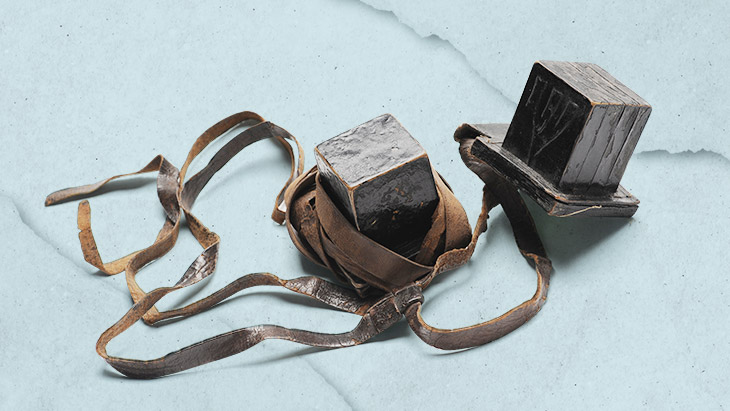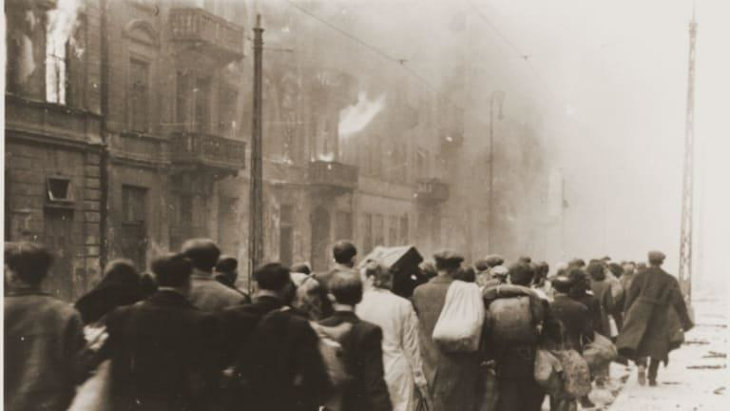 Raise a Glass to Freedom
Raise a Glass to Freedom


5 min read
Construction workers discover a secret bunker with 20 sets of tefillin, several prayer books and weapons, testifying to the spiritual resistance of Jews in the Warsaw Ghetto,.
Last week in Warsaw, a crate of tefillin (phylacteries), prayer books and weapons were found under a building that was once part of the ghetto.
Rabbi Avraham Krieger, the founder of the Holocaust research institute Shem Olam brought the incredible find to Israel. “Despite the horrors and the cruel reality in which they lived,” he told Aish.com, “the Jews in the ghetto continued to observe the customs and tradition they grew up with.”
 The tefillin were found at a construction site in the area where the Ghetto once stood
The tefillin were found at a construction site in the area where the Ghetto once stood
The Nazis created the Ghetto in November 1940, forcing around 400,000 Jews in the city and surrounding areas into a space measuring just 2.5% of the city. From the summer of 1942 deportations began to the death camp of Treblinka where the vast majority of Warsaw’s Jews were murdered.
From January 1943, the Jews began organizing themselves into a fighting force that held the German army at bay for a month before most of the ghetto was razed to the ground.
In recent years, Polish authorities have begun to demolish buildings inside the Warsaw Ghetto to turn them into residential buildings in a process of urban renewal.
“Following one such demolition, construction workers discovered an entrance to a bunker dug in preparation for the 1943 Warsaw Ghetto uprising. The discovery of 20 phylacteries concentrated in one place testifies to the Jewish lifestyle they maintained in the ghetto,” Rabbi Krieger explained. “The large number of phylacteries points to the underground prayers they succeeded in holding inside the bunker, underground and under the Nazis’ noses.”
The bunkers were found under a building at the edge of the ghetto which had an escape route to the Aryan side of the city. “There were several bunkers that connected to each other," Rabbi Krieger explained. "It is our assumption that this place functioned as a passageway which connected the two worlds. Our historians posit that this is a place that fighters and those in contact with the Aryan side of the city used as some kind of station or meeting point.”
 Jewish fighters are marched out of the ghetto in April 1943 after holding off the German army off for an entire month
Jewish fighters are marched out of the ghetto in April 1943 after holding off the German army off for an entire month
“We have people on the ground who are always looking for items like these which can shed light on the Jewish spirit of resistance during the war,” Rabbi Krieger explained. Polish government officials in Warsaw have accused Shem Olam of smuggling the items to Israel.
“On a walk around antique stores in Warsaw, you will see Torah scrolls and all kinds of Jewish artifacts; locals who find such items will happily try and sell them for a few dollars. It is a double standard for the Polish government to criticize the acquisition of artifacts like these when there is little done to stop locals making money from them.” He added, “There has also been an effort to destroy and hide artifacts that can testify to the horrors of Warsaw’s past.”
Rabbi Krieger declined to discuss how the tefillin were acquired and brought to Israel.
 20 sets of tefillin were discovered along with prayer books and weapons, courtesy Shem Olam
20 sets of tefillin were discovered along with prayer books and weapons, courtesy Shem Olam
The son of survivors from Poland who endured ghettos and Auschwitz, Rabbi Krieger founded Shem Olam in 1997 to record and educate about the Jewish spirit during the Holocaust.
“The way Jews responded to crisis demonstrates their great tremendous might and fortitude; learning about a nation from its most difficult moments, and shines a light on who they are. What was found in this bunker certainly attests to the spirit of the Jews who were using it.
“There were Jews, for whom wearing tefillin was a way of life, as natural and essential as getting dressed, eating, drinking and breathing, and those who perhaps had not been observant in practice, but for whom it was an active form of resistance.
“The Nazis wanted to reduce the Jews in the ghetto to subhuman, in their language untermen. When Jurgen Stroop, the Nazi Officer tasked with destroying the uprising took charge, he commanded to treat the Jews as vermin, so that the only thing they cared about was food. Eventually he assumed they would capitulate.”
 Rabbi Avraham Krieger founded Shem Olam in 1997
Rabbi Avraham Krieger founded Shem Olam in 1997
Rabbi Krieger added, “Putting on tefillin was and still is a reminder of the holiness and spirituality that the Jewish people aspire to; wearing tefillin showed they were the opposite of untermen.”
Now in Israel, the tefillin are being housed at Shem Olam’s archive near Netanya, but Rabbi Krieger says he wants to harness their inspiration for future generations.
“We have a project called From Childhood to Adulthood, in which we invite young Israeli schoolchildren to learn about the lives of Jews their own age during the Shoah. We would like to give young Israelis a chance to wear these tefillin even just for a few seconds – to connect them to this symbol of powerful inspiration and strength.”
